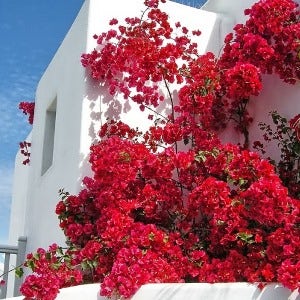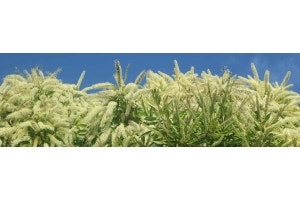
Have you always dreamt of a Grecian style garden? Do you wish you could be snacking on souvlaki in Skiathos right now, to the buzzing of a thousand cicadas? We show you how to create the look of a Greek garden in your own back yard.
 There are two notable - and very different - styles of gardening which come to mind when thinking about Greece.
There are two notable - and very different - styles of gardening which come to mind when thinking about Greece.
 Mediterranean herbs are attractive in flower, and hardy, providing food for grazing goats and sheep to make tasty meat, and nectar for pollinating bees to make delicious honey. If you grow them "hard" - ie Greek-style with minimal extra water - they are more drought-resistant and more flavoursome.
Mediterranean herbs are attractive in flower, and hardy, providing food for grazing goats and sheep to make tasty meat, and nectar for pollinating bees to make delicious honey. If you grow them "hard" - ie Greek-style with minimal extra water - they are more drought-resistant and more flavoursome.
Many bulb flowers are remarkably resilient to extremes of temperature and drought, and will multiply in favourable conditions.Plants with silver and grey leaves, and narrow slender leaves, will also survive in these challenging landscapes. The second Greek garden style is seen in every archetypal holiday village, all whitewashed houses, turquoise sea, cobalt blue doors. The Island of Santorini epitomises this - you can see it in the circle images below.
The second Greek garden style is seen in every archetypal holiday village, all whitewashed houses, turquoise sea, cobalt blue doors. The Island of Santorini epitomises this - you can see it in the circle images below. Pots are essential to bring flowering colour to roof terraces, lookout points, doorsteps, and poolside patios. White or pebble-covered pots for a chic urban look; big unglazed terracotta jars for a more rustic countryside feeling.Paint up patio furniture to match - keep it to simple shades of white and blue like the Greek flag.
Find room for a dwarf palm tree, a giant succulent plant, a miniature olive in a big bold pot - all drought-tolerant and dramatic.
Pots are essential to bring flowering colour to roof terraces, lookout points, doorsteps, and poolside patios. White or pebble-covered pots for a chic urban look; big unglazed terracotta jars for a more rustic countryside feeling.Paint up patio furniture to match - keep it to simple shades of white and blue like the Greek flag.
Find room for a dwarf palm tree, a giant succulent plant, a miniature olive in a big bold pot - all drought-tolerant and dramatic. Essential plants to get that Grecian look are fragrant herbs - choose more unusual flowering kinds and ones with grey leaves, like chamomile, oregano, thyme, santolina, rosemary, and sage. Plant them into rockeries, or in oversized terracotta amphorae for an authentic Grecian temple vibe. An olive tree is a must, whether you choose fruit or foliage as your priority.To get the holiday feeling, bright magenta or orange bougainvillea is essential. Add in drought-tolerant oleanders, annual petunias, and other colourful climbing and trailing plants for maximum colour intensity.
Essential plants to get that Grecian look are fragrant herbs - choose more unusual flowering kinds and ones with grey leaves, like chamomile, oregano, thyme, santolina, rosemary, and sage. Plant them into rockeries, or in oversized terracotta amphorae for an authentic Grecian temple vibe. An olive tree is a must, whether you choose fruit or foliage as your priority.To get the holiday feeling, bright magenta or orange bougainvillea is essential. Add in drought-tolerant oleanders, annual petunias, and other colourful climbing and trailing plants for maximum colour intensity.
Greek Style Gardens - sensory delight
 There are two notable - and very different - styles of gardening which come to mind when thinking about Greece.
There are two notable - and very different - styles of gardening which come to mind when thinking about Greece.
The first Greek garden style is inspired by the natural surroundings fround on the mainland and inland on the larger islands. Greek hillsides are rocky, dry, sunbaked - and a sensual cornucopia of herbal delights. Aromatic fragrances from native plants and wildflowers float on the warm breeze. They form seasonal meadows carpeting the landscape under ancient gnarled olives and tall resinous pines.The Spanish will no doubt fight the Greeks as to who has the greater claim to the olive; testament to the tree's ruggedness, and usefulness for fruit, oil, and wood.
 Mediterranean herbs are attractive in flower, and hardy, providing food for grazing goats and sheep to make tasty meat, and nectar for pollinating bees to make delicious honey. If you grow them "hard" - ie Greek-style with minimal extra water - they are more drought-resistant and more flavoursome.
Mediterranean herbs are attractive in flower, and hardy, providing food for grazing goats and sheep to make tasty meat, and nectar for pollinating bees to make delicious honey. If you grow them "hard" - ie Greek-style with minimal extra water - they are more drought-resistant and more flavoursome. Along the old pathways, tiny crocus, tulip, and cyclamen plants emerge each spring.
Many bulb flowers are remarkably resilient to extremes of temperature and drought, and will multiply in favourable conditions.Plants with silver and grey leaves, and narrow slender leaves, will also survive in these challenging landscapes.
Greek Style Gardens - seaside colour
 The second Greek garden style is seen in every archetypal holiday village, all whitewashed houses, turquoise sea, cobalt blue doors. The Island of Santorini epitomises this - you can see it in the circle images below.
The second Greek garden style is seen in every archetypal holiday village, all whitewashed houses, turquoise sea, cobalt blue doors. The Island of Santorini epitomises this - you can see it in the circle images below.This marine minimalism is accentuated by the most vivid bright pink and red flowering plants trained over doorways, tumbling down walls, climbing up staircases - often, but not exclusively, bougainvillea. To give a little cooling shade to a resting visitor, a grapevine - for eating or wine making - often climbs over a pergola; or is trained up a house wall to arch across the narrow alleyways.
 Pots are essential to bring flowering colour to roof terraces, lookout points, doorsteps, and poolside patios. White or pebble-covered pots for a chic urban look; big unglazed terracotta jars for a more rustic countryside feeling.Paint up patio furniture to match - keep it to simple shades of white and blue like the Greek flag.
Find room for a dwarf palm tree, a giant succulent plant, a miniature olive in a big bold pot - all drought-tolerant and dramatic.
Pots are essential to bring flowering colour to roof terraces, lookout points, doorsteps, and poolside patios. White or pebble-covered pots for a chic urban look; big unglazed terracotta jars for a more rustic countryside feeling.Paint up patio furniture to match - keep it to simple shades of white and blue like the Greek flag.
Find room for a dwarf palm tree, a giant succulent plant, a miniature olive in a big bold pot - all drought-tolerant and dramatic.
Greek Style Gardens - get the look
 Essential plants to get that Grecian look are fragrant herbs - choose more unusual flowering kinds and ones with grey leaves, like chamomile, oregano, thyme, santolina, rosemary, and sage. Plant them into rockeries, or in oversized terracotta amphorae for an authentic Grecian temple vibe. An olive tree is a must, whether you choose fruit or foliage as your priority.To get the holiday feeling, bright magenta or orange bougainvillea is essential. Add in drought-tolerant oleanders, annual petunias, and other colourful climbing and trailing plants for maximum colour intensity.
Essential plants to get that Grecian look are fragrant herbs - choose more unusual flowering kinds and ones with grey leaves, like chamomile, oregano, thyme, santolina, rosemary, and sage. Plant them into rockeries, or in oversized terracotta amphorae for an authentic Grecian temple vibe. An olive tree is a must, whether you choose fruit or foliage as your priority.To get the holiday feeling, bright magenta or orange bougainvillea is essential. Add in drought-tolerant oleanders, annual petunias, and other colourful climbing and trailing plants for maximum colour intensity.






























